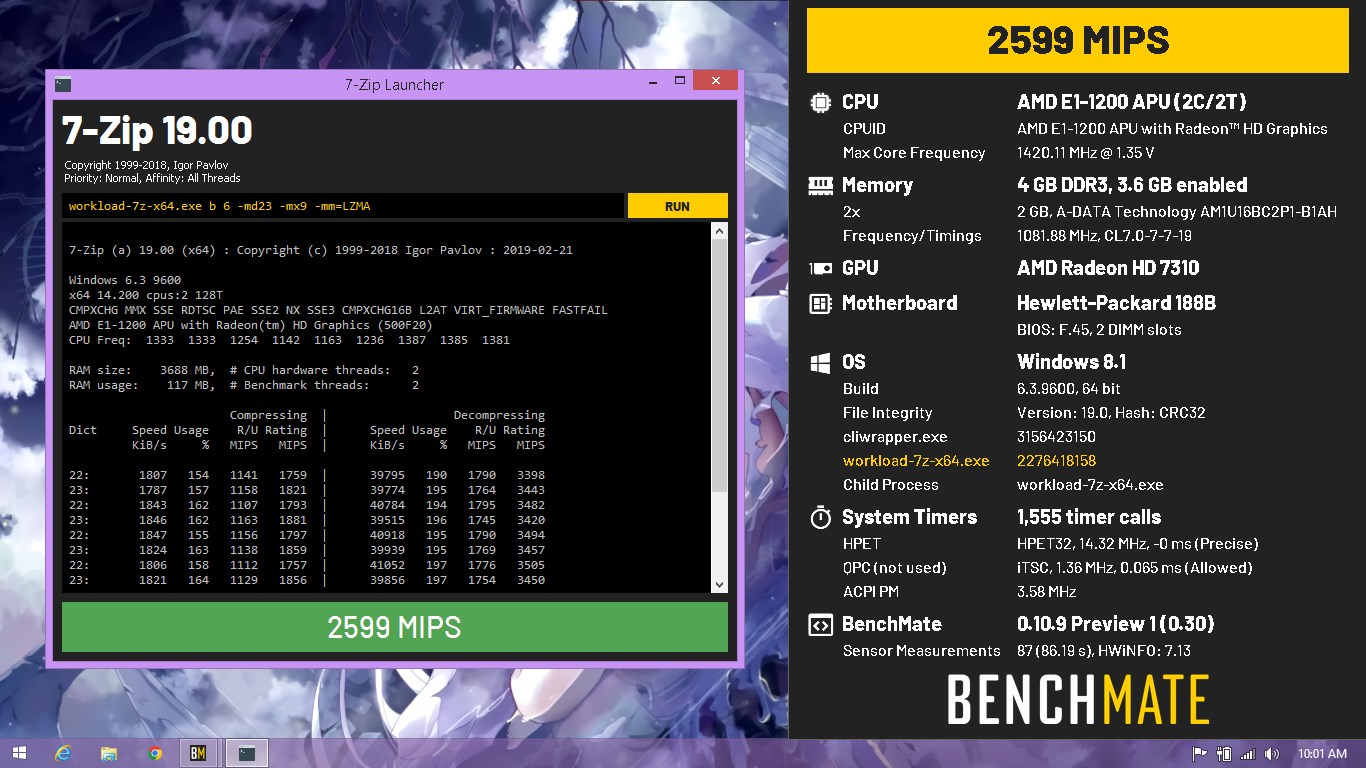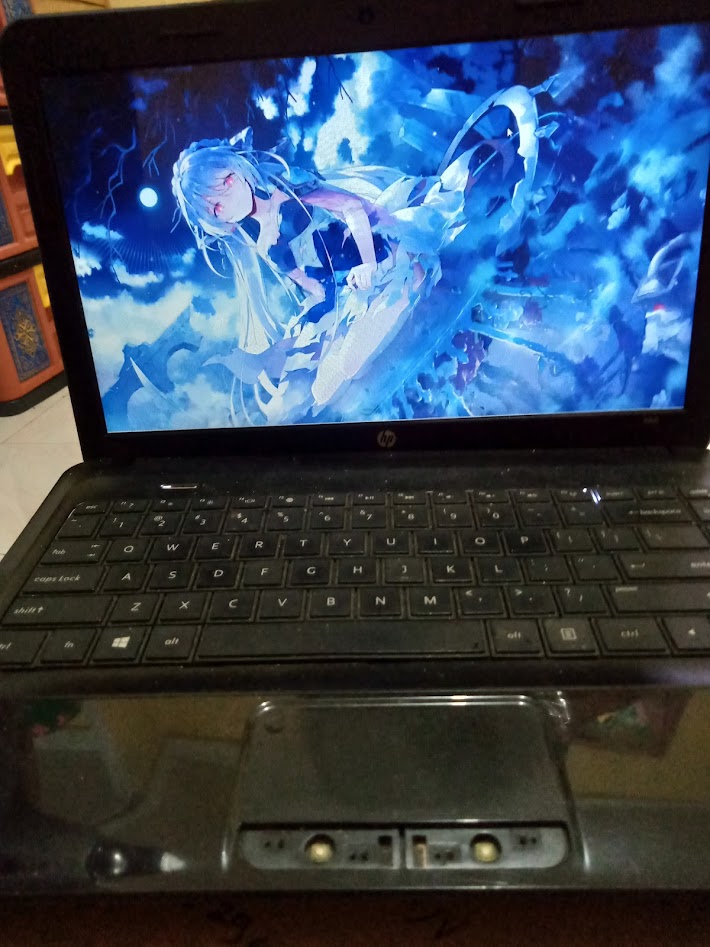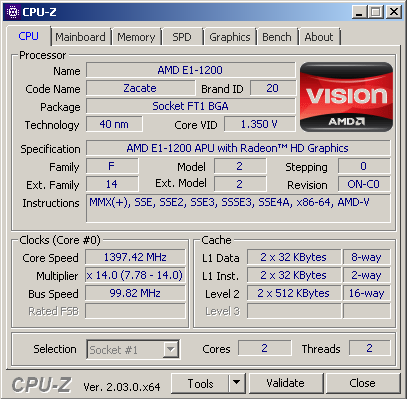7-Zip score 2599 MIPS with a E1-1200
Thursday, 01 January 1970 07:00 | Update at null
Media Gallery
Screenshot

Device, Setup, etc



URL
https://hwbot.org/submission/4989949https://www.facebook.com/hakimnu.id/posts/3276665879232719
Information Detail
Hardware: AMD E1-1200
Specs:CPUID : AMD E1-1200 APU with Radeon(TM) HD Graphics
Architecture : x86
Codename : Zacate
L3 Cache : -
Clock : 1.4GHz
Core/Thread : 2/2
TDP : 18W
Technology : 40nm
Socket : FT1 BGA 413-Ball
IGPU : AMD Radeon HD 7310
See more specification...
Software: 7-Zip
Score: 2599 MIPS
About: 7-Zip7-Zip is an open source file compression and decompression application known for its efficiency and support for various archive formats such as .7z, ZIP, RAR, TAR, and others. Besides being available in a simple graphical interface, 7-Zip can also be run via the command line or directly through shell integration in Microsoft Windows operating systems. It is widely used by home users, professionals, and system administrators due to its high compression speed and efficient use of system resources.
In the context of benchmarking, 7-Zip's performance reflects the processor's ability to handle data compression and decompression-based workloads. This benchmark is commonly used to measure CPU performance in intensive multitasking scenarios that involve manipulating large numbers of files. As the compression and decompression processes involve complex mathematical operations and algorithms, the results of this benchmark give a true picture of the processor's performance in real-world tasks.
For this test, BenchMate was used as a benchmarking platform that provides verified and standardized testing, maintaining the integrity and consistency of the results. With BenchMate, the benchmarking process runs in a tightly controlled environment, ensuring that the resulting 7-Zip benchmark score truly reflects the system's native performance without any interference from external factors such as thermal throttling, background processes, or software manipulation.
The scores generated from the 7-Zip benchmark are usually displayed in MIPS (Million Instructions Per Second), which indicates how fast the CPU can execute instructions during the compression and decompression process. A higher score means that the CPU has better performance in handling file compression tasks, which is very useful in the context of productivity, data backup, and large archive management.
With the combination of 7-Zip and BenchMate, this benchmark becomes a reliable tool for evaluating processor performance in data-intensive compression tasks in an accurate, fair and reproducible manner.
Released in 2012 as part of the Brazos 2.0 family, the AMD E1-1200 is a power-efficient processor aimed at entry-level laptops. It has a 2 core and 2 thread configuration with a fixed clock speed of 1.4 GHz, with no support for Turbo Core technology. Built with a 40nm fabrication process, the E1-1200 has a TDP value of 18 watts-efficient enough for portable devices that emphasize low power consumption and longer battery life. Despite its limited performance, the E1-1200 was a popular choice in its day thanks to its affordable price and ability to handle light computing needs.
One of the main advantages of the AMD E1-1200 is the integrated Radeon HD 7310 GPU, which offers better graphics performance than Intel's entry-level graphics solutions at the time. This GPU has the ability to play HD resolution videos smoothly, as well as run light games such as Counter Strike 1.6, Plants vs Zombies, or other casual games with minimum graphics settings. That said, this combination of CPU and GPU is not intended for heavy-duty work such as video editing, 3D rendering, or modern gaming. Overall performance is more optimal when used for tasks such as browsing, streaming videos, accessing social media, typing documents, as well as basic office applications.
However, it should be noted that the AMD E1-1200 is less suitable for heavy multitasking, especially in modern operating systems like Windows 10. With a low clock speed and no Boost feature, users may experience lag or limitations when opening multiple applications at once. In tests using the HP 1000 1b05au laptop, this processor was paired with 4GB DDR3 single channel RAM (2 DIMM slots) and tested on Windows 7, Windows 8, and Windows 10 operating systems. The results show that the most optimal performance is achieved on Windows 7 or Windows 8, while in Windows 10 the system tends to be slow although it can still be used for basic needs. As such, the AMD E1-1200 can still be relied upon as a power-efficient and inexpensive solution for users with very light computing needs.
Hardware Detail:
Device: HP 1000 1b05au
RAM: 4GB DDR3 Single Channel 2 DIMM
OS: Windows 7, Windows 8, Windows 10
* Not Avaiable
